#Cleopatra VII Thea Philopator
Explore tagged Tumblr posts
Text
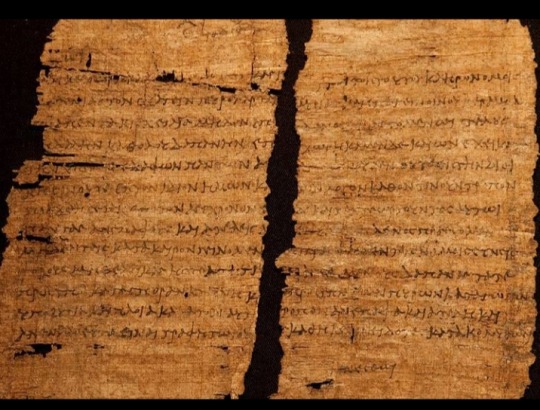
This papyrus signed by Cleopatra grants tax exemption from sales of imported wine to the Roman businessman Publius Canidius, a friend of Mark Antony.
At the bottom, in a rare example of her handwriting, Cleopatra herself added the Greek word "ginesthoi," which means "make it happen."
—
Cleopatra VII Thea Philopator (70/69 BC – 10 August 30 BC) was Queen of the Ptolemaic Kingdom of Egypt from 51 to 30 BC, and its last active ruler.
#Cleopatra#Mark Antony#Publius Canidius#Cleopatra VII Thea Philopator#Ptolemaic Kingdom#Egypt#Ancient Egypt
663 notes
·
View notes
Text

#acorigins#assassin's creed#assassin's creedassassin's creed origins#ubisoft#virtual photography#photomode#gaming photography#video games#vgedit#cleopatra#Cleopatra VII Thea Philopator#**acorigins#**#camera tools
7 notes
·
View notes
Text
“i’m confused are you Cleopatra VII or Cleopatra VIII” i’m actually both. i am the reincarnation of Cleopatra VII Thea Philopator Ptolemy but in this reincarnated form i am known as Cleopatra VIII heiress of Alexander heiress of Zeus conqueror of rome faithful of olympus mother of the nile milk-giver of humanity rightful empress of the world. hope this helps💕
30 notes
·
View notes
Text

The Hunt: Cleopatra’s Long-Lost Tomb
The Egyptian queen may rest in the ancient city of Alexandria, which now lies at the bottom of the Mediterranean.
She has one of the most captivating and enduring mythologies of any leader in history, yet the true end of Queen Cleopatra’s story remains an enigma. Archaeologists might be able to offer some clarity, if they could only find her final resting place.

The location of the Queen of the Nile’s tomb has eluded experts for centuries. Napoleon famously led an expedition searching for the crypt in the early 19th century. Egyptologists widely believe it is hidden somewhere in Alexandria, where the missing tombs of all 14 of the Ptolemaic Pharaohs, the final dynasty of ancient Egypt, are expected to be. Alas, much of ancient Alexandria now lies at the bottom of the Mediterranean Sea.
Greek historian Plutarch indicated that when Emperor Octavian ended a civil war by defeating Cleopatra and her beloved husband, the great Roman general Mark Antony, he allowed for them to be buried together. Though the prospect of finding both of their physical remains is thrilling, Plutarch wrote of their death and burial several decades after their occurrence, which casts his words into doubt.
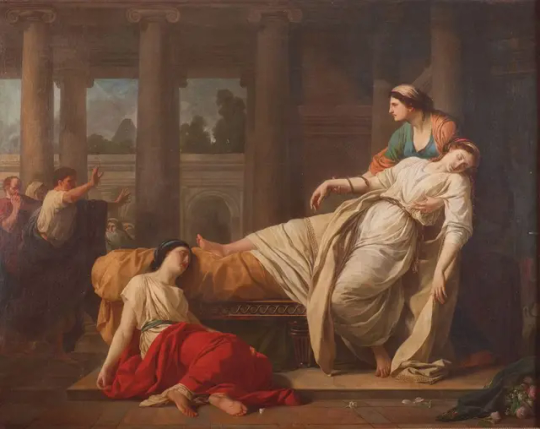
Many Egyptologists accept that both the Queen and her royal consort died dramatically by suicide, she by snakebite and he by his own sword. Others speculate that she died by intentional drug overdose, or by stinging herself with a poison-tipped hairpin. A growing number of experts suspect the suicide is a cover-up—that perhaps the queen was murdered. Much of the contemporary understanding of Cleopatra is based on the accounts of ancient Roman and Greek historians who undoubtedly held a bias towards her. An autopsy of her mummy might reveal different truths.
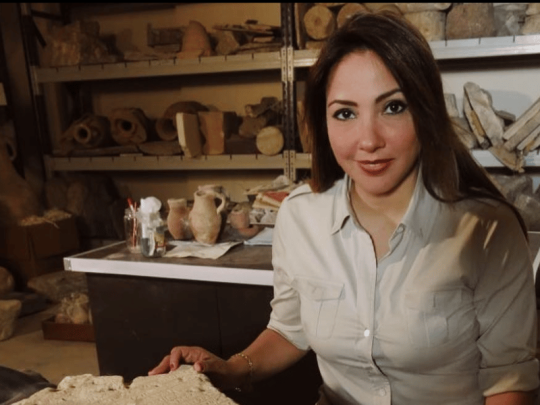
Dominican archaeologist Kathleen Martinez.
Today, the quest for Cleopatra VII Thea Philopator’s elusive burial place has been taken on primarily by Dominican archaeologist Kathleen Martinez, who has dedicated two decades of her life to this mission. Martinez subscribes to the snakebite ending. She believes the ancient queen’s suicide was a ceremonial act, part of a ritual apotheosis: shedding her mortal coil so as to ascend to the status of goddess. The ritual, Martinez theorizes, culminated in moving Cleopatra’s body from her palace to a temple 25 miles west of Alexandria, Taposiris Magna.



In 2022, Martinez announced the discovery of a tunnel running under the temple that she believes could have served as a corridor for delivering Cleopatra’s body. The tunnel is widely agreed to be an aqueduct, an exact replica of a similar structure found in Greece.
After working with Martinez for 11 years at Taposiris Magna, Zahi Hawass, former Minister of State for Antiquities Affairs of Egypt, now categorically disagrees with her. For one, it would be incredibly anomalous for a pharaoh to be interred at a temple. Furthermore, he asserts that there is “no evidence at all” to indicate that Cleopatra, ancient Egypt’s last pharaoh, is buried there.
“I believe now that Cleopatra was buried in her tomb that she built next to her palace and it is under the water,” Hawass lamented. “Her tomb will never be found.”
By Adnan Qiblawi.
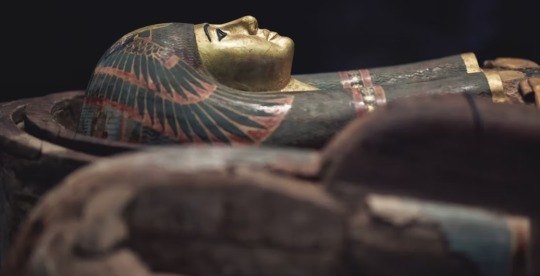
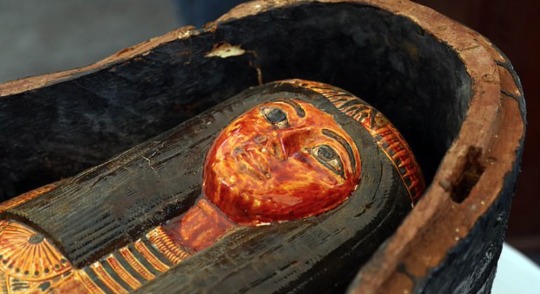
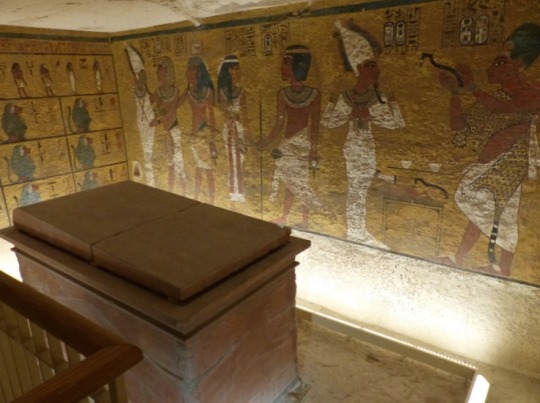
#The Hunt: Cleopatra’s Long-Lost Tomb#Queen Cleopatra#Egyptian Queen#Mark Antony#Taposiris Magna#ancient city of Alexandria#Kathleen Martinez#ancient grave#ancient tomb#ancient artifacts#archeology#archeolgst#history#history news#ancient history#ancient culture#ancient civilizations#ancient egypt#egyptian history#egyptian pharaoh
43 notes
·
View notes
Text
Famous/Important Women?
I'm trying to make a list of notable women in history (mostly for fun, partially to use against misogynists who think men did everything), and kinda not wanting to just look up a list online.
So; I'd like anyone who sees this post to add to the list. Even if all you can remember is a name and basic details, that's enough (I myself am mostly operating off memory, and then looking up details to fill in the blanks). If possible though, a date of birth/death and what they're most known for would be great, since those are the details I'm focusing on right now.
I'll add all new people/details to a list here on Tumblr so we're all on the same page info-wise.
Edit; pinning this post both so I don't have to scroll millions of miles and so it's easier for people to find (I should probably be pinning my intro post instead but whatever).
List so far:
Enheduanna (𒂗𒃶𒌌𒀭𒈾), Birthdate unknown (c. 23rd century BCE), death date unknown (c. 23rd century BCE). High Priestess of Nanna/Sin (Sumerian Moon God), Daughter of Sargon (Founder of the Akkadian Empire), Earliest Known Named Author in History.
Nitocris (Greek: Νίτωκρις). Birthdate Unknown (c. 22nd century BCE), death date unknown (c. 22nd century BCE). Possible Queen of Egypt; If So, Would Have Been the Last Queen of the Sixth Dynasty of the Old Kingdom (c.2686 – 2181 BC).
Sobekneferu (Neferusobek). Birthdate unknown (mid 18th century BC), death date unknown (mid 18th century BC). Queen of Egypt, the Last Ruler of the Twelfth Dynasty of the Middle Kingdom, Reign Lasted 3 Years, 10 Months, and 24 days, Ending in c. 1802 BC.
Hatshepsut. Born ~1507 BC, died 1458 BC. Queen of Egypt (c. 1479 – 1458 BC), Fifth Pharaoh of the 18th Dynasty of Egypt, Prolific Builder, Reigned in Peace and Prosperity.
Sappho (Modern Greek: Σαπφώ (Sapphṓ), Aeolic Greek: Ψάπφω (Psápphō)). Born c. 630 BC, died c. 570 BC. Ancient Greek Poetess, Famous for Love Poems, Symbol of Lesbian Love, Known as “The Tenth Muse”.
Timarete (Thamyris, Tamaris, Thamar (Greek: Τιμαρέτη)). Birthdate unknown (c. 5th century BC), death date unknown (c. 5th century BC). Ancient Greek Painter; According to Pliny the Elder, She "Scorned the Duties of Women and Practiced Her Father's Art." At the Time of Archelaus I of Macedon She Was Best Known for a Panel Painting of the Goddess Diana That Was Kept at the City of Ephesus.
Helena of Egypt. Birthdate unknown (4th century BC), death date unknown (c. 4th century BC). Painter, Learned From Her Father, Worked in the Period After the Death of Alexander the Great in 323 BC, Painted a Scene of Alexander Defeating the Persian Ruler, Darius III, at the Battle of Issus.
Kalypso. Birthdate unknown (c. 3rd century BC), death date unknown. Supposed Ancient Greek Painter (existence disputed).
Aristaineta. Birthdate unknown (3rd century BCE), death date unknown (3rd century BCE). Aetolian Woman, Dedicated a Large Monument at the Sanctuary of Apollo at Delphi Which Included Her Mother, Father, Son, and Herself, Which Was a Symbol of Social Status Usually Reserved For the Male Head of the Family.
The Vestal Three (Aemilia, Licinia and Marcia). Born in the 2nd century BC, died December, 114 BC (Aemilia), and 113 BC (Licinia and Marcia). Roman Vestal Virgins (Priestesses), Prosecuted For Having Broken the Vow of Chastity in Two Famous Trials Between 115 and 113 BC.
Iaia of Cyzicus (Ιαία της Κυζίκου). Born c. 2nd century BC, died c. 1st century BC. Famous Greek Painter and Ivory Carver, Most of Her Paintings are Said to Have Been of Women. According to Pliny the Elder; "No One Had a Quicker Hand Than She in Painting." Remained Unmarried All Her Life.
Cleopatra (Cleopatra VII Thea Philopator). Born ~69 BC, died August 10, 30 BC. Queen of Egypt (51 – 30 BC), Last Active Ruler of the Ptolemaic Kingdom of Egypt, Only Known Ptolemaic Ruler to Learn the Egyptian Language.
Soseono (소서노) (Yeon Soseono (연소서노)). Born 66/7 BCE, died 6 BCE. Queen Consort of Goguryeo, One of the Three Kingdoms of Korea (37 – 18 BC), Queen dowager of Baekje (Another of the Three Kingdoms) (18 – 6 BC), Founder of Baekje (18 BC).
Heo Hwang-ok (허황옥) (Empress Boju (보주태후)). Born 32 AD, died 189 AD. Legendary Queen of Geumgwan Gaya, Mentioned in Samguk yusa (a 13th-Century Korean Chronicle), Believed to Originally be From India.
Septimia Zenobia (𐡡𐡶𐡦𐡡𐡩, Bat-Zabbai). Born ~240, died ~274. Queen of Palmyra (267 – 272), Queen of Egypt (270 – 272), Empress of Palmyra (272).
Hypatia. Born c. 350–370 AD, died March, 415 AD. Neoplatonist Philosopher, Astronomer, and Mathematician, Prominent Thinker in Alexandria, Taught Philosophy and Astronomy, Beloved by Pagans and Christians Alike.
Seondeok of Silla (선덕여왕) (Kim Deokman (덕만)). Born c. 580 or 610, died 20 February, 647. Queen of Silla, One of the Three Kingdoms of Korea (632 – 647), Silla's Twenty-Seventh Ruler and First Reigning Queen, Known as a Wise and Kind Monarch.
Jindeok of Silla (진덕여왕) (Kim Seungman (김승만)). Birthdate unknown, died 654. Queen of Silla, One of the Three Kingdoms of Korea (647 – 654), Silla’s Twenty-Eighth Ruler and Second Reigning Queen, Greatly Improved Relations With China.
Jinseong of Silla (진성여왕) (Kim Man (김만)). Born c. 865, died 897. Queen of Silla, One of the Three Kingdoms of Korea (887-897), Silla’s Fifty-First Ruler, Third and Last Reigning Queen, Said to be Smart by Nature, But Whose Reign Saw the Weakening of Unified Silla.
Ende (En). Born c. 10th Century AD, died c. 10th Century AD. First Spanish Female Manuscript Illuminator to Have Her Work Documented Through Inscription.
Diemoth (Latinized: Diemudus, Diemut, Diemud, Diemuth, Diemod or Diemudis). Born c. 1060, died c. 30 March, 1130. Recluse at Wessobrunn Abbey in Upper Bavaria, Germany, Worked on 45 Manuscripts From 1075 to 1130.
Lǐ Qīngzhào (李清照) (a.k.a. Yian Jushi (易安居士)). Born 1084, died c.1155. Chinese Poet and Essayist, Defiant Visionary, Known as “The Most Talented Woman In History.”
Gunnborga (a.k.a Gunnborga den Goda (literary: 'Gunnborga the Good')). Born c. 11th century, died c. 11th century. Viking Age Swedish Runemaster, Responsible for the Hälsingland Rune Inscription 21, Known as the Only Confirmed Female Runemaster.
Hildegard of Bingen (German: Hildegard von Bingen, Latin: Hildegardis Bingensis, a.k.a Saint Hildegard/the “Sibyl of the Rhine”). Born c. 1098, died 17 September, 1179. German Benedictine Abbess and Polymath, Active as a Writer, Composer, Philosopher, Mystic, Visionary, and Medical Writer/Practitioner During the High Middle Ages.
Matilda of England (Empress Matilda, Empress Maude, the “Lady of the English”). Born c. 7 February, 1102, died 10 September, 1167. Holy Roman Empress (1114 – 1125), Disputed Queen of England (1141 – 1148).
Guda. Born 12th Century AD, died 12th Century AD. German Nun and Illuminator, One of the First Women to Create a Self-Portrait in a Manuscript.
Herrad of Landsberg (Latin: Herrada Landsbergensis). Born c. 1130, died July 25, 1195. Alsatian Nun and Abbess of Hohenburg Abbey in the Vosges Mountains, Known as the Author of the Pictorial Encyclopedia Hortus Deliciarum (The Garden of Delights) (completed in 1185).
Claricia (Clarica). Born c. 12th Century AD, died c. 13th Century AD. German Laywoman and Illuminator, Noted for Including a Self-Portrait in a South German Psalter of c. 1200.
Jefimija (Јефимија) (Jelena Mrnjavčević (Serbian Cyrillic: Јелена Мрњавчевић)). Born 1349, died 1405. Considered the First Female Serbian Poet. Her Lament for a Dead Son and Encomium of Prince Lazar are Famous in the Canon of Medieval Serbian Literature. Also a Skilled Needlewoman and Engraver.
Christine de Pizan (Cristina da Pizzano). Born September, 1364, died c. 1430. Italian-Born French Poet and Court Writer for King Charles VI of France and Several French Dukes. Considered to be One of the Earliest Feminist Writers; Her Work Includes Novels, Poetry, and Biography, and also Literary, Historical, Philosophical, Political, and Religious Reviews and Analyses.
Joan of Arc (Jeanne d’Arc, Jehanne Darc). Born ~1412, died 30 May, 1431. French Knight, Martyr, and Saint, Burned at the Stake.
Catherine of Bologna (Caterina de' Vigri). Born 8 September, 1413, died 9 March, 1463. Italian Poor Clare, Writer, Teacher, Mystic, Artist, and Saint; The Patron Saint of Artists and Against Temptations.
Elena de Laudo. Born c. 15th Century AD, died c. 15th Century AD. Venetian Glass Artist, Belonged to a Glass Painter Family of Murano, is Noted to Have Painted Blanks Delivered to Her From the Workshop of Salvatore Barovier in 1443–1445.
Maria Ormani (Maria di Ormanno degli Albizzi). Born 1428, died c. 1470. Italian Augustinian Hermit Nun-Scribe and Manuscript Illustrator, Most Notable Work is an Apparent Self-Portrait in a Breviary That She Signed and Dated 1453; the Earliest Dated Self-Portrait by a Woman Artist in Italian Renaissance Art.
Sister Barbara Ragnoni (Suor Barbara Ragnoni). Born 1448, died 1533. Italian Nun and Artist for Whom Only One Work Remains Extant; Her Signed Painting, The Adoration of the Shepherds (c. 1500).
Antonia Uccello. Born 1456, died 1491. Carmelite Nun, Noted as a "Pittoressa" (Painter) on Her Death Certificate; Her Style and Skill Remain a Mystery as None of Her Work is Extant.
Marietta Barovier. Born 15th Century AD, died c. 15th/16th Century AD. Venetian Glass Artist, the Artist Behind a Particular Glass Design from Venetian Murano; the Glass Bead Called Rosette or Chevron Bead, in 1480. In 1487 She Was Noted to Have Been Given the Privilege to Construct a Special Kiln (Sua Fornace Parrula) for Making "Her Beautiful, Unusual and Not Blown Works".
Catherine of Aragon (Katherine, Catharina, Catalina). Born 16 December, 1485, died 7 January, 1536. First Wife of King Henry VIII, Queen Consort of England (1509 – 1533).
Properzia de' Rossi. Born c. 1490, died 1530. Ground-Breaking Female Italian Renaissance Sculptor, One of Only Four Women to Receive a Biography in Giorgio Vasari's Lives of the Artists.
Anne Boleyn. Born c. 1501 or 1507, died 19 May, 1536. Second Wife of King Henry VIII, Queen Consort of England (1533 – 1536), Martyr, Executed on False Charges.
Jane Seymour. Born c. 1508, died 24 October, 1537. Third Wife of King Henry VIII, Queen Consort of England (1536 – 1537), Died of Postnatal Complications.
Levina Teerlinc. Born in the 1510s, died 23 June, 1576. Flemish Renaissance Miniaturist who Served as a Painter to the English Court of Henry VIII, Edward VI, Mary I and Elizabeth I.
Catherine Parr (Kateryn Parr). Born c. August, 1512, died 5 September, 1548. Sixth Wife of King Henry VIII, Queen Consort of England and Ireland (1543 – 1547), First English Woman to Publish an Original Work Under Her Own Name, Widowed, Remarried, Died in Childbirth.
Anne of Cleves (Anna von Kleve). Born 28 June or 22 September, 1515, died 16 July, 1557. Fourth Wife of King Henry VIII, Queen Consort of England (6 January 1540 – 12 July 1540), Marriage Annulled, Outlived All Other Wives.
Mary I of England (Mary Tudor). Born 18 February, 1516, died 17 November, 1558. First Undisputed Regnant Queen of England and Ireland (1553 – 1558), Daughter of Henry VIII and Catherine of Aragon.
Mayken Verhulst (a.k.a. Marie Bessemers). Born 1518, died 1596 or 1599. 16th-Century Flemish Miniature, Tempera and Watercolor Painter and Print Publisher, Actively Engaged in the Workshop of Her Husband, Posthumously Publishing His Works. While Recognized as an Exceptionally Skilled Artist, Little is Known About Her Works or Life as There are Few Surviving Sources.
Catherine Howard (Katheryn Howard). Born c. 1523, died 13 February, 1542. Fifth Wife of King Henry VIII, Queen Consort of England (1540 – 1541), Stripped of Title, Beheaded for ‘Treason’.
Sister Plautilla Nelli (Pulisena Margherita Nelli). Born 1524, died 1588. Self-Taught Nun-Artist, the First Ever Known Female Renaissance Painter of Florence, and the Only Renaissance Woman Known to Have Painted the Last Supper.
Caterina van Hemessen (Catharina van Hemessen). Born 1528, died after 1565. Flemish Renaissance Painter, the Earliest Female Flemish Painter for Whom There is Verifiable Extant Work, Possibly Created the First Self-Portrait of an Artist (of Either Gender) Depicted Seated at an Easel (1548).
Sofonisba Anguissola (a.k.a Sophonisba Angussola or Sophonisba Anguisciola). Born c. 1532, died 16 November, 1625. Italian Renaissance Painter, Born to a Relatively Poor Noble Family, Got a Well-Rounded Education That Included the Fine Arts; Her Apprenticeship With Local Painters Set a Precedent for Women to be Accepted as Students of Art.
Elizabeth I of England (Elizabeth Tudor, the “Virgin Queen”). Born 7 September, 1533, died 24 March, 1603. Regnant Queen of England and Ireland (1558 – 1603), Last Monarch of the House of Tudor, Daughter of Henry VIII and Anne Boleyn.
Lucia Anguissola. Born 1536 or 1538, died c. 1565 – 1568. Italian Mannerist Painter of the Late Renaissance, Younger Sister of Sofonisba, Who She Likely Trained With.
Lady Jane Grey (Lady Jane Dudley (married name)). Born ~1537, died 12 February, 1554. Queen of England for ~9 days (~10 July, 1553 – 19 July, 1553) (disputed), First Cousin Once Removed of Mary I and Elizabeth I.
Mary, Queen of Scots (Mary Stuart). Born 8 December, 1542, died 8 February, 1587. Queen of Scotland (1542 – 1567), Forced Abdication, Imprisonment, Execution.
Diana Scultori (a.k.a Diana Mantuana & Diana Ghisi). Born 1547, died 5 April, 1612. Italian Engraver From Mantua, Italy; One of the Earliest Known Women Printmakers, Making Mostly Reproductive Engravings of Well-Known Paintings/Drawings and Ancient Roman Sculptures.
Lavinia Fontana. Born 24 August, 1552, died 11 August, 1614. Italian Mannerist Painter, Active in Bologna and Rome, Best Known for Her Successful Portraiture, but Also Worked in the Genres of Mythology and Religious Painting, Regarded as the First Female Career Artist in Western Europe.
Barbara Longhi. Born 21 September, 1552, died 23 December, 1638. Italian Painter, Much Admired in Her Lifetime as a Portraitist, Though Most of Her Portraits are Now Lost or Unattributed.
Marietta Robusti. Born 1560, died 1590. Highly Skilled Venetian Painter of the Renaissance Period, the Daughter of Tintoretto (Jacobo Robusti), Sometimes Referred to as Tintoretta.
Elizabeth Báthory (Báthori Erzsébet). Born 7 August, 1560, died 21 August, 1614. Hungarian Countess, Subject of Folklore, Alleged Serial Killer.
Esther Inglis. Born 1571, died 1624. Skilled Artisan and Miniaturist Who Possessed Several Skills in Areas Such as Calligraphy, Writing, and Embroidering; Over the Course of Her Life, She Composed Around Sixty Miniature Books That Display Her Calligraphic Skill With Paintings, Portraits, and Embroidered Covers.
Galizia (Fede Galizia). Born c. 1578, died c. 1630. Italian Painter of Still-Lifes, Portraits, and Religious Pictures, Especially Noted as a Painter of Still-Lifes of Fruit, a Genre in Which She Was One of the Earliest Practitioners in European Art.
Izumo no Okuni (出雲 阿国). Born c. 1578, died c. 1613. Actress, Shrine Maiden, Creator of Kabuki Theater (1603 – 1610), Recruited Lower-Class Women For Her Troupe, Primarily Prostitutes.
Clara Peeters. Born c. 1580s/90s, death date unknown. Flemish Still-Life Painter From Antwerp Who Worked in Both the Spanish Netherlands and Dutch Republic. Was the Best-Known Female Flemish Artist of This Era and One of the Few Women Artists Working Professionally in 17th-Century Europe, Despite Restrictions on Women's Access to Artistic Training and Membership in Guilds.
Artemisia Gentileschi (Artemisia Lomi). Born 8 July, 1593, died c. 1656. Italian Baroque Painter, Considered Among the Most Accomplished 17th-Century Artists, Making Professional Work by Age 15. In an Era When Women Had Few Chances to Pursue Artistic Training/Work as Professional Artists, She Was the First Woman to Become a Member of the Accademia di Arte del Disegno and Had an International Clientele. Much of Her Work Features Women From Myths, Allegories, and the Bible, Including Victims, Suicides, and Warriors.
Magdalena van de Passe. Born 1600, died 1638. Dutch Engraver, Member of the Van de Passe Family of Artists From Cologne, Active in the Northern Netherlands. Specialized in Landscapes and Portraits, and Trained the Polymath Anna Maria van Schurman in Engraving, One of the Few Known Early Examples of the Training of One Woman Artist by Another.
Giovanna Garzoni. Born 1600, died 1670. Italian Painter of the Baroque Period; Began Her Career Painting Religious, Mythological, and Allegorical Subjects but Gained Fame For Her Botanical Subjects Painted in Tempera and Watercolor.
Michaelina Wautier (Michaelina Woutiers). Born 1604, died 1689. Baroque Painter From the Southern Netherlands (now Belgium), Noted For the Variety of Subjects and Genres She Worked in, Unusual For Female Artists of the Time, Who Were More Often Restricted to Smaller Paintings, Generally Portraits or Still-Lifes.
Judith Leyster (Judith Jans Leyster (also Leijster)). Born in July, 1609, died February 10, 1660. Dutch Golden Age Painter of Genre Works, Portraits, and Still-Lifes. Her Work Was Highly Regarded by Her Contemporaries, but Largely Forgotten After Her Death. Her Entire Oeuvre Came to be Attributed to Frans Hals or to Her Husband, Jan Miense Molenaer. In 1893, She Was Rediscovered and Scholars Began to Attribute Her Works Correctly.
Louise Moillon. Born 1610, died 1696. French Still-Life Painter in the Baroque Era, Became Known as One of the Best Still-Life Painters of Her Time, Her Work Purchased by King Charles I of England, as Well as French Nobility.
Catharina Peeters. Born 1615, died 1676. Flemish Baroque Painter, Noted For Painting Seascapes.
Katharina Pepijn (Catharina Pepijn). Born in February, 1619, died 12 November, 1688. Flemish Painter Who Was Known For Her History Paintings and Portraits.
Josefa de Óbidos (Josefa de Ayala Figueira). Born c. January, 1630, died 22 July, 1684. Spanish-Born Portuguese Painter. All of Her Work Was Executed in Portugal, Her Father's Native Country, Where She Lived From the Age of Four. Approximately 150 Works of Art Have Been Attributed to Her, Making Her One of the Most Prolific Baroque Artists in Portugal.
Maria van Oosterwijck (Maria van Oosterwyck). Born 20/27 August, 1630, died 1693. Dutch Golden Age Painter, Specializing in Richly-Detailed Flower Paintings and Other Still-Lifes. Despite the Fact That Her Paintings Were Highly Sought Out by Collectors (Including Royalty), She Was Denied Membership in the Painters' Guild Because Women Weren’t Allowed to Join. Stayed Single Throughout Her Life, but Raised Her Orphaned Nephew.
Johanna Vergouwen (Jeanne Vergouwen, Joanna Vergouwen). Born 1630, died 11 March, 1714. Flemish Baroque Painter, Copyist, and Art Dealer.
Mary Beale (née Cradock). Born in late March, 1633, died 8 October, 1699. English Portrait Painter and Writer, Part of a Small Band of Female Professional Artists Working in London. Her Manuscript Observations (1663), on the Materials and Techniques Employed "in Her Painting of Apricots", Though Not Printed, is the Earliest Known Instructional Text in English Written by a Female Painter.
Elisabetta Sirani. Born 8 January, 1638, died 28 August, 1665. Italian Baroque Painter and Printmaker Who Died in Unexplained Circumstances at the Age of 27. She Was One of the First Women Artists in Early Modern Bologna, and Established an Academy for Other Women Artists.
Maria Theresia van Thielen. Born 7 March, 1640, died 11 February, 1706. Flemish Baroque Painter, Known for Several Flower Pieces and Outdoor Still-Lifes Painted in the Style of Her Father, Jan Philip van Thielen.
Anna Maria van Thielen. Born 1641, death date unknown. Flemish Baroque Painter and Nun, Younger Sister of Maria Theresia, Older Sister of Fransisca Catharina.
Maria Borghese (Maria Virginia Teresa Borghese). Born 1642, died 1718. Italian Baroque Artist, Daughter of Art Collector Olimpia Aldobrandini.
Francisca Catharina van Thielen. Born 1645, death date unknown. Flemish Baroque Painter and Nun, Younger Sister of Maria Theresia and Anna Maria.
Maria Sibylla Merian. Born 2 April, 1647, died 13 January, 1717. German Entomologist, Naturalist and Scientific Illustrator, One of the Earliest European Naturalists to Document Observations About Insects Directly.
Élisabeth Sophie Chéron. Born 3 October, 1648, died 3 September, 1711. Remembered Today Primarily as a French Painter, but She Was a Renaissance Woman, Acclaimed in Her Lifetime as a Gifted Poet, Musician, Artist, and Academician.
Luisa Roldán (Luisa Ignacia Roldán, a.k.a La Roldana). Born 8 September, 1652, died 10 January, 1706. Spanish Sculptor of the Baroque Era, the Earliest Woman Sculptor Documented in Spain. Recognized in the Hispanic Society Museum For Being "One of the Few Women Artists to Have Maintained a Studio Outside the Convents in Golden Age Spain".
Rachel Ruysch. Born 3 June, 1664, died 12 October, 1750. Dutch Still-Life Painter From the Northern Netherlands. She Specialized in Flowers, Inventing Her Own Style and Achieving International Fame in Her Lifetime. Due to a Long, Successful Career That Spanned Over Six Decades, She Became the Best-Documented Woman Painter of the Dutch Golden Age.
Anne, Queen of Great Britain. Born 6 February, 1665, died 1 August, 1714. Queen of England, Scotland, and Ireland (1702 – 1707), First Queen of Great Britain and Ireland (1707 – 1714).
Isabel de Cisneros (Isabel de Santiago). Born 1666, died c. 1714. Criollo Colonial Painter Born in the Colony of Quito (Ecuador), Specialized in Oil Paintings of the Childhood of the Virgin and of the Baby Jesus, Adorned With Flowers and Animals.
Rosalba Carriera. Born 12 January, 1673, died 15 April, 1757. Venetian Rococo Painter; In Her Younger Years She Specialized in Portrait Miniatures, Would Later Become Known For Her Pastel Portraits, Helping Popularize the Medium in 18th-Century Europe. She is Remembered as One of the Most Successful Women Artists of Any Era.
Giulia Lama (Giulia Elisabetta Lama). Born 1 October, 1681, died 7/8 October, 1747. Italian Painter, Active in Venice. Her Dark, Tense Style Contrasted With the Dominant Pastel Colors of the Late Baroque Era. She Was One of the First Female Artists to Study the Male Figure Nude.
Anna Dorothea Therbusch (born Anna Dorothea Lisiewski (Polish: Anna Dorota Lisiewska)). Born 23 July, 1721, died 9 November, 1782. Prominent Rococo Painter Born in the Kingdom of Prussia (Modern-Day Poland). About 200 of Her Works Survive, and She Painted at Least Eighty-Five Verified Portraits.
Catherine the Great (Catherine II, Екатерина Алексеевна (Yekaterina Alekseyevna), born Princess Sophie Augusta Frederica von Anhalt-Zerbst). Born 2 May, 1729, died 17 November, 1796. Reigning Empress of Russia (1762 – 1796), Came to Power After Overthrowing Her Husband, Peter III. Under Her Long Reign, Russia Experienced a Renaissance of Culture and Sciences.
Ulrika Pasch (Ulrika "Ulla" Fredrica Pasch). Born 10 July, 1735, died 2 April, 1796. Swedish Rococo Painter and Miniaturist, and a Member of the Royal Swedish Academy of Arts.
Angelica Kauffman (Maria Anna Angelika Kauffmann). Born 30 October, 1741, died 5 November, 1807. Swiss Neoclassical Painter Who Had a Successful Career in London and Rome. Remembered Primarily as a History Painter, She Was a Skilled Portraitist, Landscape and Decoration Painter. She Was, Along With Mary Moser, One of Two Female Painters Among the Founding Members of the Royal Academy in London in 1768.
Mary Moser. Born 27 October, 1744, died 2 May, 1819. English Painter and One of the Most Celebrated Female Artists of 18th-Century Britain. One of Only Two Female Founding Members of the Royal Academy in 1768 (Along With Angelica Kauffman), She Painted Portraits But is Particularly Noted For Her Depictions of Flowers.
Anne Vallayer-Coster. Born 21 December, 1744, died 28 February, 1818. Major 18th-Century French Painter, Best Known For Still-Lifes. She Achieved Fame and Recognition Very Early in Her Career, Being Admitted to the Académie Royale de Peinture et de Sculpture in 1770, at the Age of Twenty-Six. Her Life Was Determinedly Private, Dignified and Hard-Working.
Adélaïde Labille-Guiard (née Labille/a.k.a Adélaïde Labille-Guiard des Vertus). Born 11 April, 1749, died 24 April, 1803. French Miniaturist and Portrait Painter, Was an Advocate for Women to Receive the Same Opportunities as Men to Become Great Painters. She Was One of the First Women to Become a Member of the Royal Academy, and Was the First Female Artist to Receive Permission to Set Up a Studio for Her Students at the Louvre.
Marianne Mozart (Maria Anna Walburga Ignatia Mozart). Born 30 July, 1751, died 29 October, 1829. Musician (c. 1759 – 1769), Music Teacher (1772 – 1829), Sister of Wolfgang Amadeus Mozart.
Élisabeth Vigée Le Brun (Élisabeth Louise Vigée Le Brun, born Élisabeth Louise Vigée, a.k.a. Louise Élisabeth Vigée Le Brun, Madame Le Brun). Born 16 April, 1755, died 30 March, 1842. French Painter Who Mostly Specialized in Portrait Painting, in the Late 18th/Early 19th Centuries, Made a Name For Herself in Ancien Régime Society by Serving as the Portrait Painter to Marie Antoinette, Enjoyed the Patronage of European Aristocrats, Actors, and Writers, and Was Elected to Art Academies in Ten Cities.
Marie Antoinette (Maria Antonia). Born 2 November, 1755, died 16 October, 1793. Last Queen of France (1774 – 1792), Bad Reputation, Executed by Guillotine.
Maria Cosway (Maria Luisa Caterina Cecilia Cosway (née Hadfield)). Born 11 June, 1760, died 5 January, 1838. Italian-English Painter, Musician, and Educator, Worked in England, France, and Later Italy, Cultivating a Large Circle of Friends and Clients. Founded a Girls' School in Paris (Dir. 1803 – 1809). Soon After it Closed, She Founded a Girls' College and School in Lodi, Northern Italy, Which She Directed Until Her Death.
Marguerite Gérard. Born 28 January, 1761, died 18 May, 1837. French Painter and Printmaker Working in the Rococo Style; More Than 300 Genre Paintings, 80 Portraits, and Several Miniatures Have Been Documented to Her.
Marie-Gabrielle Capet. Born 6 September, 1761, died 1 November, 1818. French Neoclassical Painter, Pupil of the French Painter Adélaïde Labille-Guiard in Paris. Excelled as a Portrait Painter; Her Works Include Oil Paintings, Watercolors, and Miniatures.
Anna Rajecka (a.k.a Madame Gault de Saint-Germain). Born c. 1762, died 1832. Polish Portrait Painter and Pastellist, Raised as a Protégée of King Stanisław August Poniatowski of Poland; In 1783, She Was Enrolled at His Expense at the Art School for Women at the Louvre in Paris. Chose to Stay in Paris After Marrying Miniaturist Pierre-Marie Gault de Saint-Germain in 1788. Became the First Polish Woman to Have Her Work Represented at the Salon in 1791.
Marie-Guillemine Benoist (born Marie-Guillemine Laville-Leroux), Born December 18, 1768, died October 8, 1826. French Neoclassical, Historical, and Genre Painter, Student of Élisabeth Vigée Le Brun.
Adèle Romany (born Jeanne Marie Mercier, a.k.a. Adèle Romanée, Adèle de Romance). Born 7 December, 1769, died 6 June, 1846. French Painter Known for Miniatures and Portraits, Especially Those of People Involved in Performing Arts.
Marie-Denise Villers (Marie-Denise "Nisa" Lemoine). Born 1774, died 19 August, 1821. French Painter Who Specialized in Portraits. In 1794, She Married an Architecture Student, Michel-Jean-Maximilien Villers. Her Husband Supported Her Art, During a Time When Many Women Were Forced to Give Up Professional Art Work After Marriage.
Constance Mayer (Marie-Françoise Constance Mayer La Martinière). Born 9 March, 1775, died 26 May, 1821. French Painter of Portraits, Allegorical Subjects, Miniatures and Genre Works. She Had "a Brilliant But Bitter Career."
Jane Austen. Born 16 December, 1775, died 18 July, 1817. English Novelist, Author of Sense and Sensibility (1811), Pride and Prejudice (1813), etc, Known For Her Subtle Criticism of the Nobility of the Time.
Marie Ellenrieder. Born 20 March, 1791, died 5 June, 1863. German Painter Known For Her Portraits and Religious Paintings, Considered to be the Most Important German Woman Artist of Her Time.
Louise-Adéone Drölling (Madame Joubert). Born 29 May, 1797, died 20 March, 1834. French Painter and Draftswoman. Both Her Father and Older Brother Were Celebrated Artists in Their Day; She Herself Was Not a Very Prolific Painter.
Mary Shelley (Mary Wollstonecraft Shelley, née Godwin). Born 30 August, 1797, died 1 February 1851. English Novelist, Author of Frankenstein (1818), Which is Considered One of the Earliest Examples of Science Fiction.
Elizabeth Barrett Browning. Born 6 March, 1806, died 29 June, 1861. Influential Poet, Author of How Do I Love Thee (Sonnet 43, 1845) and Aurora Leigh (1856).
Ada Lovelace (Augusta Ada King, née Byron, Countess of Lovelace). Born 10 December, 1815, died 27 November, 1852. Mathematician, Writer, First to Think of Other Uses for Computing Besides Mathematical Calculations.
Victoria I (Alexandrina Victoria). Born 24 May, 1819, died 22 January, 1901. Queen of England (1837 – 1901), Longest Reign of All Predecessors.
Florence Nightingale. Born May 12, 1820, died August 13, 1910. English Nurse, Pioneer of Modern Nursing, Statistics, and Social Reformation (~1853 – ?).
Rosa Bonheur. Born 16 March, 1822, died 25 May, 1899. French Artist Known Best as a Painter of Animals (Animalière). She Also Made Sculptures in a Realist Style. Was Widely Considered to be the Most Famous Female Painter of the Nineteenth Century. It’s Been Claimed That She Was Openly Lesbian, as She Lived With Her Partner Nathalie Micas For Over 40 Years Until Micas's Death.
Barbara Bodichon. Born 8 April, 1827, died 11 June, 1891. English Educationalist, Artist, and a Leading Mid-19th-Century Feminist and Women's Rights Activist. She Published Her Influential Brief Summary of the Laws of England concerning Women in 1854 and the English Woman's Journal in 1858, and Co-Founded Girton College, Cambridge (1869).
Emily Dickinson (Emily Elizabeth Dickinson). Born December 10, 1830, died May 15, 1886. American Poet, Little-Known During Her Lifetime, Most Works Published Posthumously and Heavily Edited, Later Regarded as One of the Most Important Figures In American Poetry.
Louisa May Alcott. Born November 29, 1832, died March 6, 1888. American Novelist, Short Story Writer, Poet, Author of Little Women (1868), Abolitionist, Feminist, Active in Temperance and Women’s Suffrage Movements.
Elizabeth Jane Gardner (Elizabeth Jane Gardner Bouguereau (married name)). Born October 4, 1837, died January 28, 1922. American Academic and Salon Painter, Born in Exeter, New Hampshire. She Was the First American Woman to Exhibit and Win a Gold Medal at the Paris Salon. Her Works Were Accepted to the Salon More Than Any Other Woman Painter in History, and More Than All But a Few of the Men.
Marie Bracquemond (Marie Anne Caroline Quivoron). Born 1 December, 1840, died 17 January, 1916. French Impressionist Artist, One of Four Notable Women in the Impressionist Movement, Along With Mary Cassatt, Berthe Morisot, and Eva Gonzalès. Studied Drawing as a Child and Began Showing Her Work at the Paris Salon When She Was Still an Adolescent. Never Underwent Formal Art Training, But Received Limited Instruction From Jean-Auguste-Dominique Ingres and Advice From Paul Gauguin, Which Contributed to Her Stylistic Approach.
Berthe Morisot (Berthe Marie Pauline Morisot). Born January 14, 1841, died March 2, 1895. French Painter and a Member of the Circle of Painters in Paris Who Became Known as the Impressionists. Described by Art Critic Gustave Geffroy in 1894 as One of "Les Trois Grandes Dames" (The Three Great Ladies) of Impressionism Alongside Marie Bracquemond and Mary Cassatt.
Emma Sandys (born Mary Ann Emma Sands). Born 25 September, 1841, died 21 November, 1877. British Pre-Raphaelite Painter. Her Works Were Mainly Portraits in Both Oil and Chalk of Children and of Young Women, Often in Period Clothing, Against Backgrounds of Brightly Coloured Flowers.
Maria Zambaco (Marie Terpsithea Cassavetti (Greek: Μαρία Τερψιθέα Κασσαβέτη)). Born 29 April, 1843, died 14 July, 1914. British Sculptor of Greek Descent, Was Also an Artist's Model, Favored by the Pre-Raphaelites.
Kitty Kielland (Kitty Lange Kielland). Born 8 October, 1843, died 1 October, 1914. Norwegian Landscape Painter.
Marie Stillman (Marie Spartali (Greek: Μαρία Σπαρτάλη)). Born 10 March, 1844, died 6 March, 1927. British Member of the Second Generation of the Pre-Raphaelite Brotherhood. Of the Pre-Raphaelites, She Had One of the Longest-Running Careers, Spanning Sixty Years and Producing Over One Hundred and Fifty Works. Though Her Work With the Brotherhood Began as a Favorite Model, She Soon Trained and Became a Respected Painter.
Mary Cassatt (Mary Stevenson Cassatt). Born May 22, 1844, died June 14, 1926. American Painter and Printmaker, Born in Pennsylvania and Lived Much of her Adult Life in France, Where She Befriended Edgar Degas and Exhibited With the Impressionists. Often Created Images of the Social and Private Lives of Women, With Particular Emphasis on the Intimate Bonds Between Mothers and Children. Described by Gustave Geffroy as One of "Les Trois Grandes Dames" (The Three Great Ladies) of Impressionism Alongside Marie Bracquemond and Berthe Morisot.
Elizabeth Thompson (Elizabeth Southerden Thompson, later known as Lady Butler). Born 3 November, 1846, died 2 October, 1933. British Painter Who Specialized in Painting Scenes From British Military Campaigns and Battles, Including the Crimean War and the Napoleonic Wars.
Lilla Cabot Perry (born Lydia Cabot). Born January 13, 1848, died February 28, 1933. American Artist Who Worked in the American Impressionist Style, Rendering Portraits and Landscapes in the Freeform Manner of Her Mentor, Claude Monet. She Was an Early Advocate of the French Impressionist Style and Contributed to its Reception in the United States. Her Early Work Was Shaped by Her Exposure to the Boston School of Artists and Her Travels in Europe and Japan.
Anna Boch (Anna-Rosalie Boch). Born 10 February, 1848, died 25 February, 1936. Belgian Painter, Art Collector, and the Only Female Member of the Artistic Group, Les XX. Part of the Neo-Impressionist Movement.
Anna Bilińska (a.k.a. Anna Bilińska-Bohdanowicz). Born 8 December, 1854, died 8 April, 1893. Polish Painter, Known For Her Portraits. A Representative of Realism, She Spent Most of Her Life in Paris, and is Considered the "First Internationally Known Polish Woman Artist."
Cecilia Beaux (Eliza Cecilia Beaux). Born May 1, 1855, died September 17, 1942. American Artist and the First Woman to Teach Art at the Pennsylvania Academy of the Fine Arts. Known For Her Elegant and Sensitive Portraits of Friends, Relatives, and Gilded Age Patrons, She Painted Many Famous Subjects Including First Lady Edith Roosevelt, Admiral Sir David Beatty and Georges Clemenceau.
Evelyn De Morgan (Mary Evelyn Pickering). Born 30 August, 1855, died 2 May, 1919. English Painter Associated Early in Her Career With the Later Phase of the Pre-Raphaelite Movement, and Working in a Range of Styles Including Aestheticism and Symbolism. Her Paintings Rely on a Range of Metaphors to Express Spiritualist and Feminist Content; Her Later Works Also Dealt With Themes of War From a Pacifist Perspective.
Lucy Bacon (Lucy Angeline Bacon). Born July 30, 1857, died October 17, 1932. Californian Artist Known for Her California Impressionist Oil Paintings of Florals, Landscapes and Still Lifes. Studied in Paris Under the Impressionist Camille Pissarro; The Only Known Californian Artist to Have Studied Under Any of the Great French Impressionists.
Laura Muntz Lyall (Laura Adeline Muntz). Born June 18, 1860, died December 9, 1930. Canadian Impressionist Painter and Art Teacher, Known for Her Sympathetic Portrayal of Women and Children.
Olga Boznańska. Born 15 April, 1865, died 26 October, 1940. Polish Painter and Art Teacher of the Turn of the 20th Century. She Was a Notable Painter in Poland and Europe, and Was Stylistically Associated With French Impressionism, Though She Rejected This Label.
Suzanne Valadon (Marie-Clémentine Valadon). Born 23 September, 1865, died 7 April, 1938. French Painter Who, in 1894, Became the First Woman Painter Admitted to the Société Nationale des Beaux-Arts. Shocked the Artistic World by Painting Male Nudes as well as Less Idealized Images of Women (in Comparison to Those of Her Male Counterparts).
Mademoiselle Abomah (Ella Williams). Born October, 1865, death date unknown (after 1920s). African-American Performer, Giantess Who Grew to Eight Feet Tall.
Anna Connelly. Born September 23, 1868, died ~1969. Inventor of the First Fire Escape (1887), One of the First Women to Patent an Invention Without Help From a Man.
Emma Goldman. Born June 27, 1869, died May 14, 1940. Anarchist Revolutionary, Political Activist, Writer, Played a Pivotal Role in Development of Anarchist Philosophy in North America and Europe In the First Half of the 20th Century.
Ella Ewing, “The Missouri Giantess” (Ella Katherine Ewing). Born March 9, 1872, died January 10, 1913. Giantess, Performer, Considered the World’s Tallest Woman of Her Era.
Helen Keller (Helen Adams Keller). Born June 27, 1880, died June 1, 1968. Blind/Deaf, Disability Rights/etc. Activist (1909 – ?), Author (1903 – ?).
Agatha Christie (Dame Agatha Mary Clarissa Christie, Lady Mallowan, DBE (née Miller)). Born 15 September, 1890, died 12 January, 1976. English Writer, Known For Her 66 Detective Novels and 14 Short Story Collections. Dubbed “The Queen of Crime”.
Amelia Earhart (Amelia Mary Earhart). Born July 24, 1897, died January 5, 1939 (in absentia). First Solo Female Pilot (1932), Women's Rights Activist, Lost at Sea (1937).
Ebony and Ivory (Margaret Patrick and Ruth Eisenburg). Born 1902 (Eisenburg)/1913 (Patrick), died 1996 (Eisenburg)/1994 (Patrick). Elderly Interracial Piano Duo (1983 – 1988), Disabled on Opposite Sides.
Virginia Hall (Virginia Hall Goillot, Codenamed Marie and Diane, Known as “Artemis” and ”The Limping Lady” by the Germans). Born April 6, 1906, died July 8, 1982. WWII-Era Intelligence Agent (1940 – 1945), Considered “The Most Dangerous of All Allied Spies” by the Gestapo, Later Joined the CIA (1947 – 1966), Had Prosthetic Leg.
Li Zhen (李贞) (Li Danmeizi (旦妹子)). Born February, 1908, died March 11, 1990. Revolutionary (1927 – ?), First Female General of the People’s Liberation Army (1955 – ?).
Mother Teresa (Mary Teresa Bojaxhiu (born Anjezë Gonxhe Bojaxhiu)). Born 26 August, 1910, died 5 September, 1997. Albanian-Indian Catholic Nun, Founder of the Missionaries of Charity.
Rosa Parks (Rosa Louise McCauley Parks). Born February 4, 1913, died October 24, 2005. Civil Rights Activist (1943 – ?), Played a Pivotal Role in the Montgomery Bus Boycott (1955), Became Symbol of Resistance to Racial Segregation.
Judy Garland (Frances Ethel Gumm). Born June 10, 1922, died June 22, 1969. Award-Winning Singer/Actress (1924 – 1969), Starred in The Wizard of Oz (1939), A Star Is Born (1954), etc.
Stephanie Kwolek (Stephanie Louise Kwolek). Born July 31, 1923, died June 18, 2014. Award-Winning Chemist, Inventor of Kevlar (1965).
Marilyn Monroe (Norma Jeane Mortenson). Born June 1, 1926, died August 4, 1962. Award-Winning Actress (1945 – 1961), Pop/Sex Icon of Hollywood’s Golden Age, Starred in Gentlemen Prefer Blondes (1953), Some Like It Hot (1959), etc.
Ursula K. Le Guin (Ursula Kroeber Le Guin). Born October 21, 1929, died January 22, 2018. American Novelist, Best Known For Her Works of Speculative Fiction, Author of the Earthsea Series (1964 – 2018), The Left Hand of Darkness (1969), The Dispossessed (1974), etc.
Aretha Franklin (Aretha Louise Franklin). Born March 25, 1942, died August 16, 2018. Award-Winning Gospel/Rock/RnB Singer, Songwriter, Pianist, Civil Rights Activist, Record Producer (1954 – 2017).
Liza Minnelli (Liza May Minelli). Born March 12, 1946, Still Living. Award-Winning Actress, Singer, Dancer, and Choreographer (1961 – present), Daughter of Judy Garland.
Afeni Shakur (Afeni Shakur Davis, Born Alice Faye Williams). Born January 10, 1947, died May 2, 2016. American Political Activist, Member of the Black Panther Party (1968 – 1971), Mother of Tupac Shakur.
Assata Shakur (Assata Olugbala Shakur (Born JoAnne Deborah Byron), A.k.a. Joanne Chesimard). Born July 16, 1947, Still Living. American Political Activist, Convicted of Murder, Former Member of the Black Liberation Army, One of the FBI's "Most Wanted Terrorists", Friend of Afeni Shakur & Mutulu Shakur, Often Described as Their Son Tupac Shakur's "Godmother" or "Step-Aunt", Currently a Fugitive, in Asylum in Cuba.
(P.S. if I got anything wrong, feel free to correct me.)
#women in history#historical figures#important people#list#help#women's rights#activist#activism#activists#inventors#pilot#pilots#aviation#queens#royalty#science#scientists#inventions#kevlar#Cleopatra#ancient egypt#egypt#Anna Connelly#Helen Keller#Amelia Earhart#female pilot#Pioneer#pioneers#lost at sea#Rosa Parks
29 notes
·
View notes
Note
Morning everyone, ready for the big day?

The sun rose on the Transient Megalopolis, and you prepared yourselves for the Flaming Bout.
After a good night's rest and a decent morning that quickly became a bit more frantic once you realized how the time was slipping by, you made your way to where the bout was supposed to be held.
Today was the day. And it was a 'big day' indeed!
Even on a decent time-frame- and you all thought you were getting there pretty early- the streets were crowded as they amassed around a huge arena.
Just wave after wave of people. Compared to your past memory, where each individual was more of a 'vaguely colored mechanical thing'- and even your recollection of the Nameless City which had primarily human-like citizens, you saw all types here. Humans, robots, beast-men… the works.

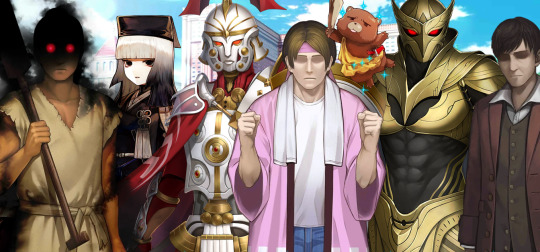
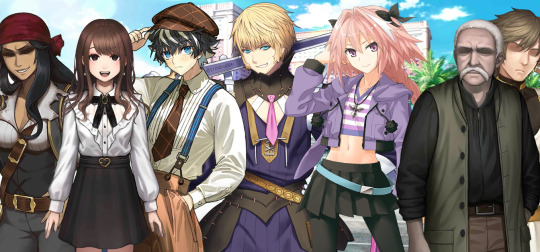

You supposed that in a virtual world where you could look like anyone, these kinds of disparate appearances wasn't exactly odd, but it was surreal in a way. It was hard to tell who was a competitor, and who just looked incredibly intense.
The good news was, you really didn't stand out that much. In a vacuum, a 'shadow person' was rather ominous and actively strange. in this situation? Well, if you ever wanted to assert that you looked 'relatively normal', now would be the time to do so. Nobody could really argue.
Still, there wasn't much time to admire the diversity of the Solar Cell, as you were being actively squished between your Servants as they tried to push through the waves of people.

CONSTANTINE: "Just… stay close to the Masters! If they got lost in this wave of people, I don't think we could find them easily!"
NERO: "It's not like we have a choice but to stay close, Rider! I barely have room to wiggle my fingers! I forgot what massive crowds came here for the Bout!"
SABER: "Still… it's pretty exciting, isn't it? This is a major event! Ah-- hey, Rider! That's my foot!"
CONSTANTINE: "That wasn't me! Wait, there's a break in the crowd Push! Onward!"
You shoved your way through the crowd, as you heard various bits and pieces of excited chatter.
"Hey, did you hear? Keeper Ptolemaios is here!" "Seriously? I don't think I've seen him anywhere but the Archives or the Library…" "I wonder... do you think something happened?"
"So many strong fighters… maybe this is a good year to get into betting…" "Dude, you still owe me 50 PPT, what the hell are you gonna bet with?"
"Mm? Where's Protector Quetzalcoatl? She's always here, right?" "I thought I saw her… I think she changed her hair?" "Ah, that was her?!"
"I've got a good feeling on the Man-Slayer this year... I just know it!" "No way! Tri-Star's got this in the bag!" "You're kidding, right? I heard that the Jaguar Boss brought in a last-minute fighter that's supposed to be a total killer!"
The constant noise was only tempered briefly by the sound of a heavy object slamming into the ground. Eyes whipped towards the source, as you saw DURYODHANA and IZOU proudly standing before the crowd.

DURYODHANA: "Make way, citizens! The ruler of the Transient Megalopolis is coming through! Move it! Shoo!"
IZOU: "Y'hear that punks!? Queen Cleopatra's comin', so back off and start gettin' respectful!"
They parted to the side, as a stately, beautiful woman stepped between them. Your eardrums practically burst from the amount of yelling that emerged from the crowd, which basically confirmed the identity of this person.

CLEOPATRA VII THEA PHILOPATOR. The final Pharaoh of the Greco-Egyptian Ptolemaic Dynasty.
And… the Lair Servant of the Transient Megalopolis. The 'Pharaoh'.
You saw her briefly shoot a look at her two guards, sharing a hushed conversation.
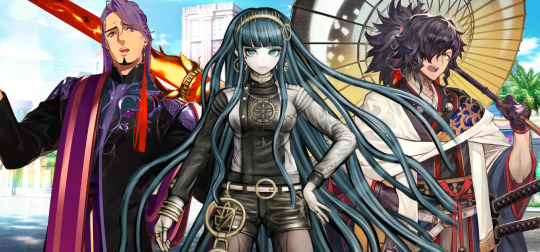
CLEOPATRA: "You boneheads. We really need to work on your introductions…"
IZOU: "Really? I think I nailed it. What, you think I should'a asked 'em to bow?"
DURYODHANA: "They moved, didn't they? I say mission accomplished. No need to coddle them, they adore you after all."
CLEOPATRA: "…You're both lucky you're strong and handsome, you know that?"
She sighed, before smiling and waving to the crowd of people, that-- despite the brusque announcement from the two guards-- were absolutely ecstatic to see the Pharaoh of the Megalopolis in person. And considering that DURYODHANA and IZOU were fighters as well, you could assume some of that excitement was shared for them as well. She made her way through the crowd, before vanishing, and the normal bustle returned… unfortunately.
MUSASHI: "Gaaah! My foot!"
CONSTANTINE: "That time was me, sorry! Are you okay? Ah- wait, we're losing the little one!"
'LITTLE GUY': "We're going awayawaaaaaay-!"
NERO: "I've got you! Oh, look! There's that damned Jaguar! Ahead! Ahead! No, we're drifting left! No, no, noooo--!"
Eventually-- EVENTUALLY-- you managed to reach JAGUAR MAN who was waiting by the entrance. She smirked, folding her arms.
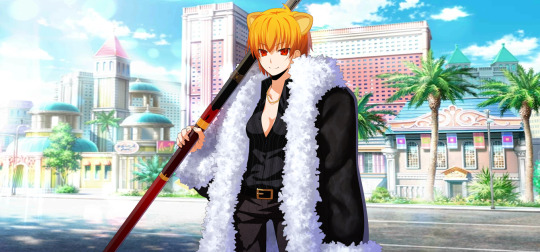
JAGUAR MAN: "The crowd got you, huh? That's the city for ya. You're lucky you're newbies- at least you don't have to worry about paparazzi or superfans hounding you. Welcome to the Flaming Bout. Glad y'could make it. Anyways, let's get down to brass tacks. Twin-blade and Shady here--"
You're assuming that she's talking to MUSASHI and you.
JAGUAR MAN: "--Head down to the locker rooms as soon as possible and get checked in. Your friends better find seats quick, this place fills up fast for people not in VIP sections."

CONSTANTINE: "We're not allowed down?"
JAGUAR MAN: "Sorry, handsome. Don't worry, the fighters are allowed up to mingle when they're off call, so you'll have plenty of chances to waste time together. Just make sure you don't miss your bout. Here you go."
You received: [ Flaming Bout Tickets (1 Fighter Ticket, 1 Manager Ticket, and 3 Guest Tickets) ]!
[ You lost 400 PPT for your Entry Fee! You currently have 770 PTT! ]
JAGUAR MAN handed you the ticket marked 'Manager', while MUSASHI took the ticket marked 'Fighter' and the other three took the remaining. MUSASHI's ticket was bright red with a golden border. Your ticket had a sleek black design with a golden border- it looked important. Best to make sure you didn't lose it. The guest tickets had simple flame patterns.
With a petulant look, NERO stared down at her ticket.
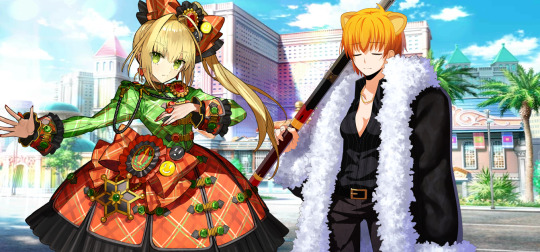
NERO: "…I want a VIP ticket."
JAGUAR MAN: "Tough luck. If you had your War Monitor status, it'd be a cinch, but now you've gotta run with everyone else... Still, knowing you, you'll probably find a way into the Lounge somehow."

JAGUAR MAN: "Anyways, I'll see ya down below. I've got high hopes for you, 'Null Zero Samurai'."
She winked, before heading inside the building, leaving you and your group.
14 notes
·
View notes
Text
Quick reminder that Gaius Julius Ceasar invented being a power bottom and Cleopatra VII Thea Philopator invented being a girl boss
8 notes
·
View notes
Text
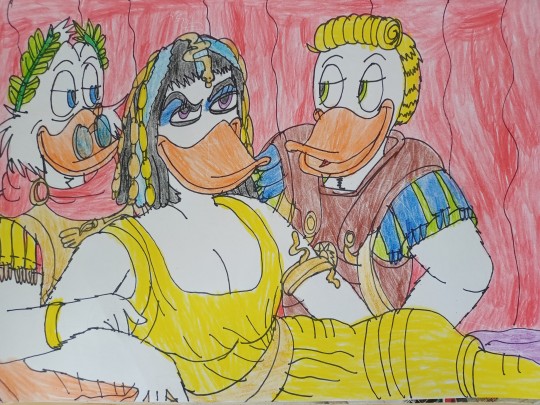


Cleopatra in Duckverse - Magica De Spell as Cleopatra - History in Duckverse
I drew this back in March, but here I am posting now related to Duckmber and on the subject of History, one of my favorite subjects and definitely my profession. And yes, I drew related to my part of the Duckverse in AU history, but in my own way.
I drew Magica De Spell in the role of Cleopatra, the famous Egyptian queen and the last queen of Egypt, from the first century BC. Yes, Cleopatra's real name was Cleopatra VII Thea Philopator who was born in 70/69 BC and died in 30 BC. Because Magica is a love charm and attracts various men and I added her as Cleopatra, since Cleopatra has a similar role, especially when she attracts Julius Caesar and Mark Antony. So Magica as Cleopatra, Scrooge as Caesar and Gladstone as Mark Antony. Yes, this is a link to both Dimeshipping and Magicstone, since I like both love couples (although I prefer Dimeshipping for my own reasons), so there's no need to argue about ship couples, and I don't like it either, let everyone like what they want. So this is a good way of connecting both love couples, but in a historical context. By the way, this is a redraw from the poster from the movie Cleopatra from 1963, in which Elizabeth Taylor played Cleopatra, Richard Burton played Mark Antony, and Rex Harrison played Caesar. Yes, it is one of my favorite Hollywood movies. Yes, Magica was modeled after actresses Gina Lollobrigida, Sophia Loren and Elizabeth Taylor, so there's a reason why I put Magica as Cleopatra. Yes, there is in the Italian Topolino comics where Cleopatra appears, but it is more of a Daisy role than Magica. I prefer Magica as Cleopatra.
I hope you like this drawing and these love couples and these ideas, feel free to like and reblog this. Just please, don't use ideas like this without mentioning me and without my permission. And yes, this is only from a historical context, so you don't have to like these couples if you don't want to (everyone is entitled to their own opinion), but these are my ideas, and this is just a part of the past.
#my fanart#duckmber2023#cleopatra#duckverse#ducktales#history#duck comics#movies#ducktales 2017#magica de spell#scrooge mcduck#gladstone gander#julius caesar#mark antony#disney ducks#disney duckverse#otp#love couples#cosplays#ancient history#egypt#rome#disney goose#fanart#duckverse in history#my headcanons#dimeshipping#magicstone#magica x gladstone#scrooge x magica
22 notes
·
View notes
Text
if you are not some kind of idiot who can’t read, you may know that the race of Cleopatra VII Thea Philopator, inasmuch as the modern concept of race may be applied to persons from the first century before the current era, is not especially up for question. Her family was of northern Greek origin, she was Greek.
#stop saying it’s not known#it is known and you don’t want to think about Hellenic empire because that’s not how you want to think about history#stop looking stupid in front of me#sorry your girlboss isn’t girlbossing the way you want. she was still one of the politicians of all time
6 notes
·
View notes
Text
considering putting Bambietta and Tatsuki on their own blogs (as together with Yoruichi they form the local Monster Trio) and then adding Cyan and Emilou here to keep the balance at eight
problems are coming up with URLs for them, and also figuring out where tf Cyan is even from
my feeling given Franceska ought to be French (it's literally in her name) and Emilou ought to be American (it's in her surname), is that Cyan ought not be Asian; her given name suggests Greek, because she's named after the color and that's where it comes from
interestingly their reimagined TYBW designs seem to be sort of Northern European "barbarian", Roman, and Egyptian, respectively, which might be clues as France was invaded by Franks (among others), America drew heavy inspiration from Rome, and Egypt was "liberated" by the Greeks in the form of Alexander the Great and thereafter ruled by the Ptolemys (with Cyan looking not a little like Elizabeth Taylor's portrayal of Cleopatra [VII Thea Philopator])
... "Sung-Sun" is also wrong, by the way, it should be "Sun-Sun" with no difference between the two parts, and as we've discussed before these transcriptions of sound are not necessarily accurate either, just as close as Japanese can happen to get
but what from the Mediterranean region sounds even sorta like that...
2 notes
·
View notes
Text
Cleopatra
Queen of the Ptolemaic Kingdom of Egypt

The Berlin Cleopatra, a Roman sculpture of Cleopatra wearing a royal diadem, mid-1st century BC (around the time of her visits to Rome in 46–44 BC), discovered in an Italian villa along the Via Appia and now located in the Altes Museum in Germany.
Cleopatra VII Thea Philopator was Queen of the Ptolemaic Kingdom of Egypt from 51 to 30 BC, and its last active ruler. A member of the Ptolemaic dynasty, she was a descendant of its founder Ptolemy I Soter, a Macedonian Greek general and companion of Alexander the Great.
Born: January 69 BC, Alexandria, Egypt

The Death of Cleopatra (1658), by Guido Cagnacci
Died: August 30 BC, Alexandria, Egypt
Spouse: Ptolemy XIII Theos Philopator (m. 50 BC–48 BC), Mark Antony (m. 32 BC–30 BC), Ptolemy XIV Philopator (m. ?–48 BC)
Children: Cleopatra Selene II, Caesarion, Alexander Helios, Ptolemy Philadelphus
Parents: Ptolemy XII Auletes, Cleopatra V
Siblings: Ptolemy XIII Theos Philopator, Ptolemy XIV Philopator, Arsinoe IV, Berenice IV
Grandchildren: Ptolemy of Mauretania, Drusilla of Mauretania the Elder, Julia of Mauretania

Cleopatra DENIED
I mean, can you blame him? Look at that smile!
12K notes
·
View notes
Text

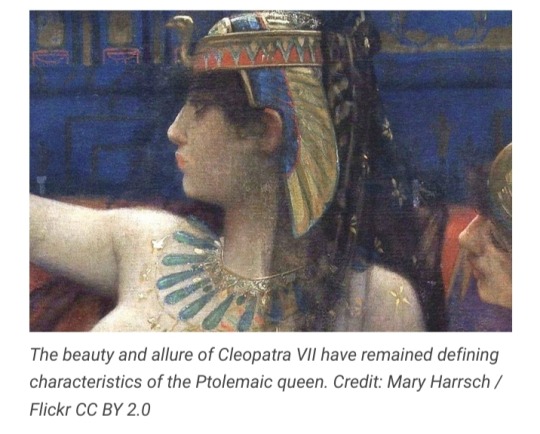
A significant part of Cleopatra VII Philopator’s enduring reputation is as one of history’s most famous femme fatales, renowned for her beauty and wit which attracted not one, but two of the Roman Republic’s most powerful men.
Whether or not this popular characterization of Cleopatra is historically accurate, her reputation has led many to wonder whether she had any particular beauty secrets that she used to ensure Julius Caesar and Mark Anthony.
The historical record does provide some clues as to how the Ptolemaic dynasty’s most famous ruler presented herself, from hairstyles to clothing, and even makeup.
Although we cannot be entirely certain how she presented herself, there are enough historical details to piece together a reasonable picture of how Cleopatra might have presented herself.
Was Cleopatra really a beauty?
As the old adage goes, “Beauty is in the eye of the beholder.”
As far as the ancient sources are concerned, the question of Cleopatra’s beauty raised mixed responses, with some ascribing an irresistible physical appearance to her and others attributing her allure more to her intellect and charm.
For example, Cassius Dio (164 to c. 235 AD), an ancient Greek historian, described Cleopatra as “a woman of surpassing beauty.”
During the first meeting between Julius Caesar and Cleopatra, Cassius Dio wrote:
"Caesar, upon seeing her and hearing her speak a few words, was so completely captivated that the Roman general acquiesced immediately to Cleopatra’s requests."

Plutarch (c.46 to c.119 AD) also briefly commented on the Ptolemaic queen’s appearance in his Life of Mark Anthony.
Contrary to Cassius Dio, Plutarch did not reckon Cleopatra’s beauty to be particularly noteworthy but instead praised her intelligence and character.
“Her beauty, so we are told, was not itself outstanding; it did not immediately strike those who saw her; yet being with her had an inescapable hold; when talking with her, she was persuasive, and the character which surrounded her whole manner in company had a force to it,” wrote the Greek historian and philosopher.
Hair and makeup
In the few surviving marble busts of Cleopatra, she is depicted wearing her hair tied at the back in a bun.
Historians like Paul Edmund Stanwick refer to this as a “melon hairstyle.”
Coinage depicting the queen shows her wearing the same hairstyle.
Depictions of Cleopatra with this hairstyle also show her wearing a diadem, a symbol of royal power adopted by many Hellenistic rulers who succeeded Alexander the Great as the masters of the divided fragments of his empire.

Professor Diana Kleiner of Yale University has identified two more hairstyles worn by Cleopatra.
One of these hairstyles emulated those worn by Macedonian queens, which is unsurprising given Cleopatra’s lineage.
To achieve this style, the hair was carefully divided into individual curls, which were typically swept away from the face and elegantly gathered into a bun positioned at the back.
According to Professor Keline, it may have been worn during travel.
The other hairstyle was “the usual Egyptian wigged headdress that had its origins in Pharaonic times.”
In this case, the main point of attention would have been the headdress rather than the hair itself, with a rearing cobra made of precious metal proudly displayed.

Professor Kleiner explains that “Cleopatra appears to have worn different coiffures in different circumstances, playing to her audience, so to speak, in life and in art.”
It would have been important for her to present herself in the Hellenistic fashion to the Greek elites who held the most senior positions in Ptolemaic Egypt, but also in traditional Egyptian fashions for her ruler to appear legitimate to a native Egyptian audience.
Regarding the Ptolemaic queen’s makeup choices, she would darken her eyebrows and enhance her eyeliner using black kohl, creating an elongated look.
The application of deep blue eyeshadow extended gracefully up to her brows, further accentuating her eyes.
Additionally, Cleopatra embraced the fashionable trend of adorning her hands with intricate henna patterns, a popular practice during that era in Alexandria.
Clothing
Cleopatra wore a variety of Greek, Egyptian, and Roman outfits intended to accentuate her beauty.
The selection of these styles would have been dependent on the contexts in which the queen appeared, as it was important for her to present herself accordingly to her friends, foes and subjects.
One of the styles she wore combined Greek and Egyptian aesthetic sensibilities and is seen depicted on sculptures of other Ptolemaic queens.
This style consisted of a sheer dress, likely of a semi-transparent material, which left the bare breasts exposed in a manner popular amongst native Egyptian women.
The depictions of other Ptolemaic queens wearing this style are consistent with the writings of the Roman poet Lucan, who claimed that she wore a transparent dress that exposed her breasts, likely made of Chinese silk.
Lucan also described the jewelry she wore, writing that “her baleful beauty inordinately painted, covered with Red Sea pearls, a fortune in her hair and around her neck, weighed down with jewelry.”
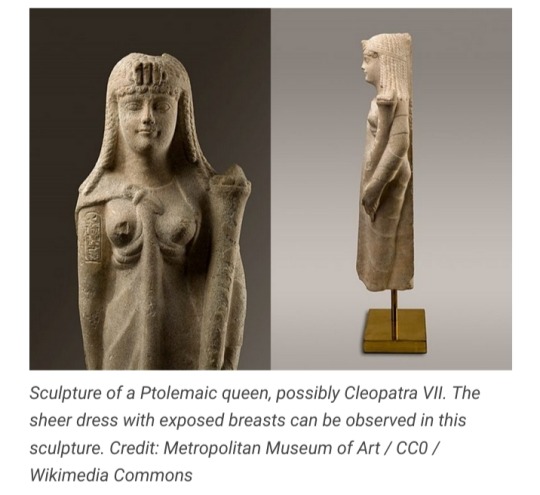
NOTE:
Cleopatra VII Thea Philopator (70/69 BC – 10 August 30 BC) was Queen of the Ptolemaic Kingdom of Egypt from 51 to 30 BC and its last active ruler.
A member of the Ptolemaic dynasty, she was a descendant of its founder, Ptolemy I Soter, a Macedonian Greek general and companion of Alexander the Great.
#Cleopatra VII Thea Philopator#Cleopatra#Queen of the Ptolemaic Kingdom of Egypt#Ptolemaic Dynasty#Ancient Egypt#Ptolemy I Soter#Ancient Macedonians#Julius Caesar#Mark Anthony#Cassius Dio#Plutarch#melon hairstyle#Egyptian fashion#Lucan#Ptolemaic Queen#Hellenistic fashion#Alexandria#Beauty Secrets of Cleopatra
53 notes
·
View notes
Text
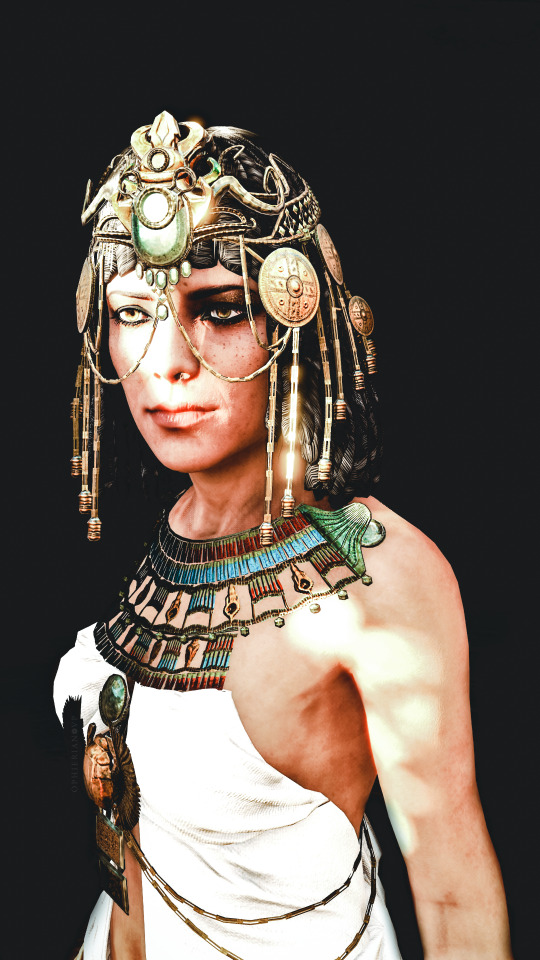
#assassin's creed origins#gamingedit#acorigins#assassin's creed#assassin's creedassassin's creed origins#ubisoft#virtual photography#photomode#gaming photography#video games#vgedit#cleopatra#Cleopatra VII Thea Philopator#**acorigins#**#in game photography#camera tools
6 notes
·
View notes
Text
Gaius Julius Ceasar and Cleopatra

Gaius Julius Caesar (101 - 44 BC/BCE) and Cleopatra (69 - 31 BC/BCE)
Gaius Julius Caesar was a general, consul, triumvir and dictator of Rome, for some its first emperor de facto. He met Cleopatra when he pursued his rival Pompey in Egypt, and helped her recover the throne. In this period, they became lovers. Afterwards, Cleopatra lived for several years in Rome, as Caesar's guest, together with their son, Cesarion. He was assassinated on the Ides of March, in a conspiracy that should have saved the Republic, but instead decreed its definitive disappearance.
Cleopatra VII Thea Philopator was the last queen of Egypt. Belonging to the Ptolemaic dynasty, dating back to the Macedonian kingdom of Alexander the Great, she was a woman of extreme culture and very devoted to her kingdom. She was also the mother of Caesar's only son, Ptolemy XV Caesar, nicknamed Caesarion (little Caesar), who, after Caesar's death, tried to have him recognized as his heir in place of his nephew Octavian, with the help of general Marcus Antonius.
#aesthetic#history#history aesthetic#ancient egypt#ancient rome#caius julius caesar#cleopatra#mark antony#caius julius ceasar and cleopatra#gaius julius caesar#gaius julia caesar and cleopatra#julius ceasar#julius ceasar and cleopatra#historical ship#historical romance
0 notes
Text

Cleopatra VII Thea Philopator (69 BC – August 10, 30 BC) was Queen of the Ptolemaic Kingdom of Egypt (51-30 BC) and its last active ruler. A member of the Ptolemaic dynasty, she was a descendant of its founder Ptolemy I Soter, a Macedonian Greek general and companion of Alexander the Great. Her first language was Koine Greek, and she is the only Ptolemaic ruler known to have learned the Egyptian language. After her death, Egypt became a province of the Roman Empire, marking the end of the last Hellenistic-period state in the Mediterranean, a period which had lasted since the reign of Alexander (336–323 BC).
She was born to the ruling Ptolemaic pharaoh Ptolemy XII and an uncertain mother, presumably Ptolemy XII’s wife Cleopatra V Tryphaena (who may have been the same person as Cleopatra VI Tryphaena) the mother of Cleopatra’s older sister, Berenice IV Epiphaneia. Cleopatra Tryphaena disappears from official records a few months after the birth of Cleopatra in 69 BC. The three younger children of Ptolemy XII, Cleopatra’s sister Arsinoe IV, and brothers Ptolemy XIII Theos Philopator and Ptolemy XIV were born in the absence of his wife. Her childhood tutor was Philostratos, from whom she learned the Greek arts of oration and philosophy. During her youth, she studied at the Museum, including the Library of Alexandria. #africanhistory365 #africanexcellence
0 notes
Text
Top 5 @Wikipedia pages from yesterday: Thursday, 25th April 2024
Welcome, आपका स्वागत है (āpakā svāgata hai), fáilte, merħba 🤗 What were the top pages visited on @Wikipedia (25th April 2024) 🏆🌟🔥?

1️⃣: Richard Gadd "Richard Robert Steven Gadd (born 11 May 1989) is a Scottish writer, actor and comedian. He created and starred in the 2024 Netflix drama series Baby Reindeer, based on his one-man show and real-life experience. ..."
2️⃣: 2024 Indian general election "General elections are being held in India from 19 April to 1 June 2024 in seven phases, to elect 543 members of the Lok Sabha. The votes will be counted and the results will be declared on 4 June 2024. This is the largest-ever election in history, surpassing the 2019 Indian general election, and..."
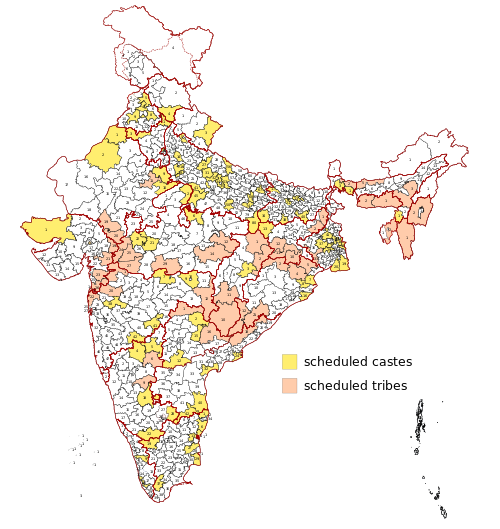
Image licensed under CC BY-SA 3.0? by Furfur
3️⃣: Baby Reindeer "Baby Reindeer is a British black comedy drama-thriller miniseries created by and starring Richard Gadd. An adaptation of Gadd's autobiographical one-man show of the same name, the series is based on Gadd's real life experience of being stalked and sexually assaulted in his twenties. The series..."
4️⃣: 2024 NFL draft "The 2024 NFL draft is the ongoing 89th annual meeting of National Football League (NFL) franchises to select newly eligible players. The draft is being held around Campus Martius Park and Hart Plaza in Detroit, Michigan, on April 25–27, 2024. The Chicago Bears held the first pick in the draft,..."
5️⃣: Cleopatra "Cleopatra VII Thea Philopator (Koinē Greek: Κλεοπάτρα Θεά Φιλοπάτωρ lit. Cleopatra "father-loving goddess"; 70/69 BC – 10 August 30 BC) was Queen of the Ptolemaic Kingdom of Egypt from 51 to 30 BC, and its last active ruler. A member of the Ptolemaic dynasty, she was a descendant of its founder..."
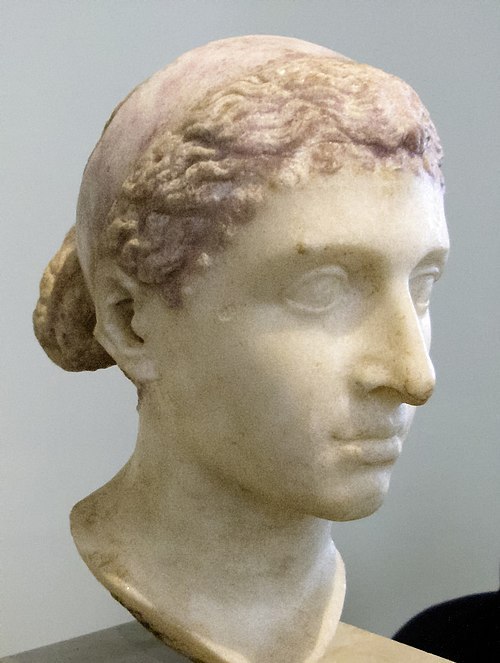
Image by Louis le Grand
0 notes